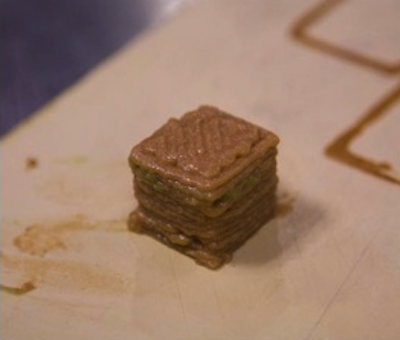
A science-fictiony proposal in Wired suggests future astro-colonists could feast on dishes prepared by 3D food printers.
The concept seems like a good one; current astronauts are subjected to freeze-dried packets of former food, brought back from the dead by injection of lubricating water. While astros put on a brave face when describing their food, one can only imagine how terrible it must be, particularly for long-duration expeditions.
Can we solve this with 3D printing? We’re skeptical. Currently food printers are only experiments and speculation. Most experiments involve only a single print material, erm, foodstuff. While 3D printed food items may be technically edible, they tend to lack the attractiveness of properly prepared food: Consider the questionably delicious 20mm deep fried turkey cube image above, an early food printing experiment. Perhaps more culinary experts should assist the engineers working on food printing?
A useful space 3D food printer (did we just say that?) would have to be capable of printing in multiple foodstuffs, offer a variety of cooking options, be entirely food safe and operate in a weightless environment without creating spaceship hazards such as grease fires, etc.
That’s a very tall order for anyone working on the topic. And we’re unaware of anyone doing so.
Even if a “space 3D food printer” were developed, there’s a major problem: print time. As Fabbaloo readers know, 3D printing just isn’t very fast and those waiting in line for their dish to be printed will not be happy. It’s more than likely astronauts will starve.
Yay food packets!
Via Wired


With SOME emerging technologies.. Progress is fast, even exponential.
With others, it's a dead end, And with others, progress is slow and non linear.
And with others, it seems fast, based in what the observer is aware of, and ubderstands.
Moore's law does not apply to everything, and it is not an actual law of physics. It's a throwaway statement that happens to have rung more or less true for some time.
Progress has no metronome.
So sorry.. "In the future" printing could still be dead slow, and a much better, faster, more efficient method could be used. Or not. We can not reliably predict that far forward. Which is why we have computers, but not flying cars or meals in a pill. And why robots make stuff in factories, not kitchens.
What lack of vision. As with all new emerging technologies their rate of progress is immense, even exponential. Think mainframe pc –> desktop.